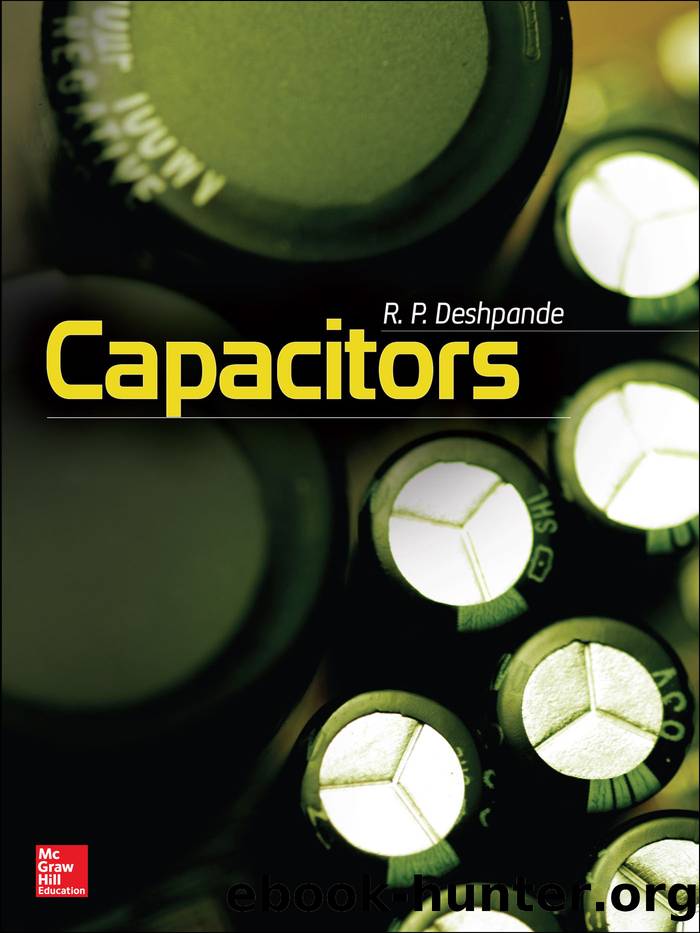Capacitors by R. P. Deshpande;

Author:R. P. Deshpande; [Deshpande;, R. P.]
Language: eng
Format: epub
ISBN: 9780071848572
Publisher: McGraw-Hill
Published: 2015-09-15T05:00:00+00:00
Fig. 10.6 Dieletric system of electrolytics.
The thickness of oxide dielectric layer is about 1.4â1.5 nm/volt of formation voltage. This means a thinner oxide layer for lower voltage, which in turn means that for lower voltages, the gain of formed foil and capacitance density is significantly higher. The high currents associated with motor start capacitors necessitate an increase in foil thickness, and lower gain (more foil area for same capacitance), usually give better performance, longer AC voltage withstand time, lower power factor (lower watt loss), and better life.
The loss factor for electrolytics is relatively high, and the ESR is also considerable. In DC applications, the watt loss is not of much consequence, except when the ripple voltage and frequency is considerable. In AC circuits, however, this is a major consideration, as the heat generated during even short duty cycle of a few seconds can be damaging. The duty cycle of motor start capacitors is mainly governed by the heat generated, which can damage the capacitor itself. The duty cycle is generally specified as 15 to 20 starts of motor per hour, each start being of maximum 3 s duration. Loss factors of 1.8% to 4% are common, and in some cases may go to 7%. Every effort is made in the manufacturing process to achieve the lowest possible loss factor.
(b) Cathode
The cathode aluminium foil is generally thinner than the anode and exhibits much higher capacitance than the anode, since the cathode capacitance appears in series with the anode capacitance to yield the total capacitance. The maximum total capacitance occurs when the cathode capacitance is as large as possible. High cathode capacitance requires a very low cathode formation voltage. Cathode is etched, but not formed at all, although there is always a thin layer (around 2â3 nm) of hydrous oxide on the surface of aluminium. A thin hydrous oxide layer forms readily on aluminium with exposure to normal air in the atmosphere. Titanium passivation of cathode foil has been undertaken in recent years to offer a cathode with a capacitance approaching 200 μF/cmâ2. Such a high cathode capacitance is necessary only for low-voltage capacitors with high-gain anodes. Generally a cathode capacitance of fifty times the anode capacitance is sufficient. This situation yields a total capacitance which is only 2% less than the anode capacitance.
A thin foil with a surface etch is used for the cathode, giving a frequency response generally better than that of the anode, and giving capacitance so large that the total unit capacitance is not diminished. Since the cathodeâs voltage capability is usually only about one volt, the electrolytic capacitor unit is limited in its steady-state reverse voltage capability to about one volt. Extended reverse voltage for time intervals as short as one second can cause significant heating of the electrolyte and of the anode oxide. The current drawn during these reverse voltages can easily reach hundreds of amperes.
Note: In AC motor start capacitors, since two capacitors are connected back to back, and cathode need not have any external
Download
This site does not store any files on its server. We only index and link to content provided by other sites. Please contact the content providers to delete copyright contents if any and email us, we'll remove relevant links or contents immediately.
Learning SQL by Alan Beaulieu(6056)
Weapons of Math Destruction by Cathy O'Neil(5871)
Digital Minimalism by Cal Newport;(5416)
iGen by Jean M. Twenge(5187)
Sapiens by Yuval Noah Harari(5135)
The Age of Surveillance Capitalism by Shoshana Zuboff(4005)
Elon Musk by Ashlee Vance(3872)
Thing Explainer by Randall Munroe(3799)
Apollo 8 by Jeffrey Kluger(3518)
Future Crimes by Marc Goodman(3383)
The Science Book (Big Ideas Simply Explained) by DK(3153)
Who Can You Trust? by Rachel Botsman(3036)
I Live in the Future & Here's How It Works by Nick Bilton(2854)
Infinite Energy Technologies by Finley Eversole(2842)
Steve Jobs by Walter Isaacson(2770)
Dawn of the New Everything by Jaron Lanier(2695)
The Innovators: How a Group of Hackers, Geniuses, and Geeks Created the Digital Revolution by Walter Isaacson(2543)
Chernobyl by Serhii Plokhy(2444)
Ben Franklin's Almanac by Candace Fleming(2392)
